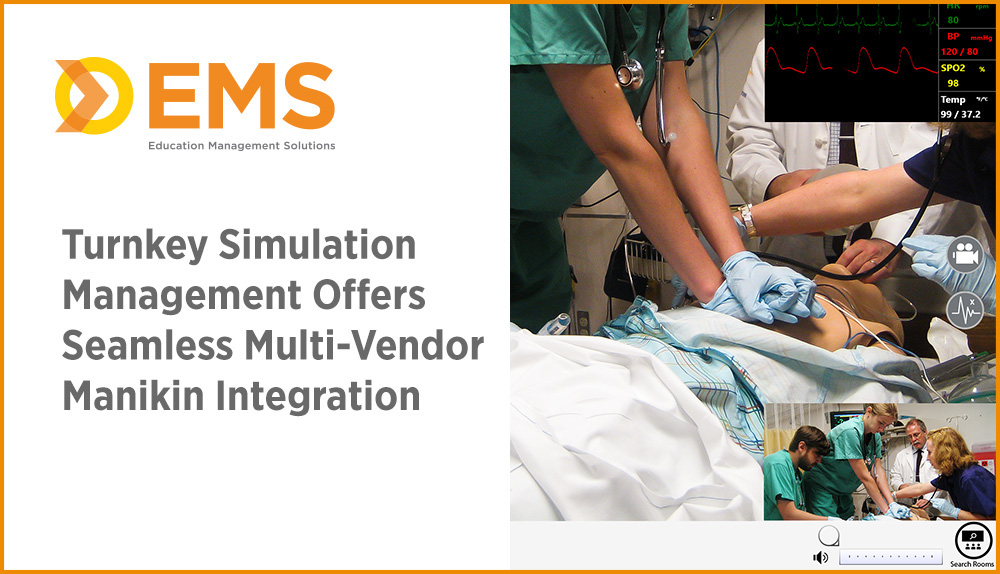Turnkey Simulation Management from EMS Offers Seamless Multi-Vendor Manikin Integration
Healthcare simulation programs that utilize a variety of clinical simulation manikins (patient simulators), or manikins from multiple vendors, are not alone. However, logistics can present a challenge, which is where healthcare simulation management technology comes into play. With manufacturer agnostic live manikin integration functionality, simulationists are able to seamlessly connect a wide variety of disparate assets, sources and systems within a single interface. Here are six ways simulation management technology helps these professionals and learners simply manage manikins from multiple vendors within a single, integrated dashboard.
1. Centralized Operations: Whether a healthcare simulation program utilizes two manikins or 20, clinical simulation management technology connects all assets, equipment and resources in a single, centralized location. This empowers leaders to take charge of every aspect of their multi-room, in situ and virtual patient training; schedule, record, score and debrief; and maximize return on investment (ROI).
2. Automated Workflows: Things can get a little hectic when dozens (if not hundreds) of people use a simulation center and manikins every semester. Healthcare simulation management technology streamlines workflows and saves leaders time with automated asset scheduling, reporting, statistical analysis and competency tracking. This not only helps them justify the need for continued budgetary requirements, but also helps them to manage your assets and plan for the future.
Sponsored Content:
3. Integrated Manikin Voice Control: A healthcare simulation management solution’s manufacturer agnostic live manikin integration functionality empowers faculty. The solution also helps healthcare simulation technicians to increase the intensity of their exercises through scenario and voice control, leading to a more immersive student experience.
4. Inventory and Utilization Tracking: Keep track of manikins and task trainers, supplies and drugs, and determine who is using a healthcare simulation room/center, at what times, and for what purposes. Usage metrics help simulationists avoid scheduling snafus, identify available supply quantities, calculate ROI and gain administrative buy-in for inventory or space expansion.
5. Seamless Observation and Review: Healthcare simulation sessions can get a boost in realism when multiple manikins, task trainers or even standardized patients (SPs) are used at once — but reviewing each element can be a daunting task. Integrated management technology makes simultaneously viewing streaming video, learners’ actions and vital signs from multiple manikins — and manikin types — possible for evaluators.
6. Powerful Debriefing: Post-event debriefing is one of the single most important components of any clinical simulation exercise. With management technology that seamlessly and intuitively integrates with each manikin, learners can further benefit from powerful, manikin event log-enhanced debriefings.
Sponsored Content:
Manikin Integration Success Story: MGH College of Health Professions
The MGH Institute of Health Professions, a graduate school founded by Massachusetts General Hospital in Boston, Massachusetts, operates two separate but interconnected environments for clinical training. This includes the four-room MGHIHP simulation center, which serves a diverse population of undergraduate and graduate-level nursing, physician assistant (PA) and occupational and physical therapy learners, among others, and the Sanders IMPACT Practice Center, which offers uniprofessional and interprofessional training opportunities within 14 multipurpose rooms, and a space for members of the community to receive free, team-based healthcare and health education.
The MGHIHP clinical simulation center is also home to a variety of manikins from multiple vendors. Mike Trioli, simulation education specialist, explains: “I keep up with what our faculty needs: I bring them in and demonstrate [the manikins] and see which one they like the best, and that’s the one I purchase. I have no problem supporting either manufacturer’s products.”
As there are several hundred learners that come through the MGHIHP healthcare simulation center weekly and thousands of scenarios conducted every semester, Trioli knew he needed to offer faculty and learners a standardized, high-quality simulation workflow — no matter what manikin their scenario utilized.
SIMULATIONiQ Enterprise, a turnkey simulation management platform from Education Management Solutions (EMS), offered a clear answer for the MGHIHP simulation center. This was especially true given that the platform was already being leveraged within the Sanders IMPACT Practice Center.
“We wanted to take the next step in our simulation, and within our digital environment. We were looking for a system that wasn’t just going to be a glorified video recorder. SIMULATIONiQ Enterprise is very heavily used in the IMPACT Practice Center for observation, live viewing, recording and debriefing, as well as OSCEs,” Jorge Sanchez de Lozada, director of technology and web services, reflected on the initial decision to purchase SIMULATIONiQ Enterprise.
More About Education Management Solutions
Education Management Solutions (EMS) and their brand SIMULATIONiQ is a leading healthcare simulation company that provides audiovisual recording debriefing systems, learning management systems, A/V design consulting, online learning systems, counseling training systems and virtual patient simulations, as well ROI and competency-based evaluation systems.
Medical, nursing and allied health schools, hospitals and counseling programs use EMS’ suite of products to more efficiently manage their in-person, online and hybrid simulation-based training initiatives, effectively evaluate learner performance and digitally document simulated events. As the leader in clinical simulation management technology since its founding in 1994, EMS provides a complete turnkey solution that includes integrated software and hardware, virtual and online solutions, design and planning, engineering, configuration, installation, training and support.
Learn More About EMS
Gwen Wille is the Content Marketing Manager at Education Management Solutions.
Sponsored Content:






















